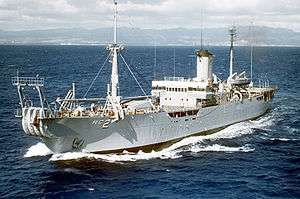USNS Neptune (ARC-2)
 | |
| History | |
|---|---|
| Name: | USS Neptune ex William H. G. Bullard |
| Builder: | Pusey & Jones Corp., Wilmington, Delaware |
| Launched: | 22 August 1945 |
| Acquired: | February 1946 |
| Commissioned: | 1 June 1953 |
| Decommissioned: | 1991 |
| Struck: | 20 August 1992 |
| Fate: | Recycled in late 2005 |
| Notes: | Ship underwent modifications as USS Neptune and a major modernization in 1982 with resulting changes in specifications. |
| General characteristics | |
| Type: | S3-S2-BP1; Army cable ship, later USN Cable Repair Ship (ARC) |
| Displacement: | 7,400 long tons (7,519 t) |
| Length: | 362 ft 0 in (110.34 m) |
| Beam: | 47 ft 0 in (14.33 m) |
| Draft: | 25 ft (7.6 m) |
| Propulsion: | 2 × Skinner Uniflow Reciprocating Steam Engines; changed to turbo-electric in 1982; twin shafts |
| Speed: | 14 knots (26 km/h; 16 mph) |
| Complement: | 71 civilians, 6 Navy, 25 technicians |
| Armament: | None |
USNS Neptune (ARC-2), was the lead ship in her class of cable repair ships in U.S. Naval service. The ship was built by Pusey & Jones Corp. of Wilmington, Delaware, Hull Number 1108, as the USACS William H. G. Bullard named for Rear Adm. William H. G. Bullard. She was the first of two Maritime Commission type S3-S2-BP1 ships built for the US Army near the end of World War II. The other ship was the Albert J. Myer, which later joined her sister ship in naval service as the USNS Albert J. Myer. The ship was built by Pusey & Jones Corp. of Wilmington, Delaware as Hull Number 1108.[1]
Function
Neptune's assignments were typically to transport, deploy, retrieve and repair submarine cables, test underwater sound devices, and conduct acoustic, hydrographic, and bathymetric surveys.
Career
Neptune may have done some cable work for the Army soon after delivery in 1946 (unverified at present), but she was soon handed to the Maritime Commission and placed in the reserve fleet.
In 1953, Neptune was activated by the Navy to support the SOSUS program. She went to the Bethlehem Steel Co. in Baltimore, Maryland for a number of modifications: e.g., electric cable machinery (in place of steam), precision navigation instrumentation, and a helicopter platform over the fantail. She was commissioned on 1 June 1953 as a regular Navy ship USS Neptune (ARC-2), with Cdr. Robert A. Bogardus in command.
In 1973, Neptune transferred to the Military Sealift Command (MSC), was re-designated T-ARC-2, and continued operations with a mostly civilian crew. Neptune was extensively modernized in 1982 by General Dynamics Corp. in Quincy, Massachusetts, and that work included new turbo-electric engines. It is said that Neptune and sister ship USNS Albert J. Myer (T-ARC-6) were the last ships in the Navy to operate using reciprocating steam engines.
Neptune performed cable repair duties all over the world until 1991, when she'd been in service for some 38 years. During her career, she received a Navy E ribbon in 1988.
Inactivated in 1991, she was eventually placed in the James River reserve fleet near Ft. Eustis, VA. The ex-Neptune was dismantled and recycled by International Shipbreaking Ltd. of Brownsville, TX in late 2005.
References
- ↑ http://www.shipbuildinghistory.com/history/shipyards/2large/inactive/pusey.htm | Shipbuilding History - Pusey & Jones, Wilmington DE
- This article incorporates text from the public domain Dictionary of American Naval Fighting Ships. The entry can be found here.
- The Ships and Aircraft of the U.S. Fleet, Norman Polmar, Naval Institute Press, 13th edition, 1984.
- OPNAV NOTICE 1650, Master List of Unit Awards and Campaign Medals, 9 March 2001.
- MARAD press release 14-05, 28 July 2005, Maritime Administration announcement of the disposal of ex-Meyer & ex-Neptune.
External links
- Photo gallery of Neptune at NavSource Naval History
- Life on the USS Neptune ARC-2
- USS Neptune (ARC-2) / USNS Neptune (T-ARC-2)
| ||||||||||||||